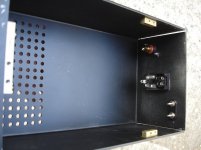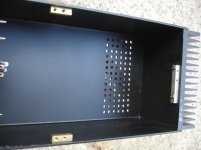I'm going to use Hammond aluminium enclosures for my amp and pre-amp builds. To make them living-room friendly I'll get them powder coated.
The problem is, where the sheet metal is folded at the corners, there is a ~2x1mm gap on the apex. Along with the join of about ~1mm on the welded edge. See attached.
Is there anything I could fill this with prior to powder coating?
Thanks
The problem is, where the sheet metal is folded at the corners, there is a ~2x1mm gap on the apex. Along with the join of about ~1mm on the welded edge. See attached.
Is there anything I could fill this with prior to powder coating?
Thanks
Attachments
Thanks Jon - I'll check that stuff out.
The chassis are fine for guitar amps, hidden in the cab and behind a face plate. But yes, for this purpose the Hammonds are a bit of a let down. One of the two I've just received from Mouser is 'warped' so will need a bit of TLC.
The problem is the lack of places locally (or even in the UK in general) who are able / willing to do one-offs for a reasonable cost. And even then, there's no guarantee they'd give a hoot about quality...
The chassis are fine for guitar amps, hidden in the cab and behind a face plate. But yes, for this purpose the Hammonds are a bit of a let down. One of the two I've just received from Mouser is 'warped' so will need a bit of TLC.
The problem is the lack of places locally (or even in the UK in general) who are able / willing to do one-offs for a reasonable cost. And even then, there's no guarantee they'd give a hoot about quality...
I have the same problem🙁I'm going to use Hammond aluminium enclosures for my amp and pre-amp builds. To make them living-room friendly I'll get them powder coated.
The problem is, where the sheet metal is folded at the corners, there is a ~2x1mm gap on the apex. Along with the join of about ~1mm on the welded edge. See attached.
Is there anything I could fill this with prior to powder coating?
Thanks
Attachments
I have the same problem🙁
There is a great argument to make the enclosure black! I was hoping for white...
Body filler is (from my costly experience) not going to work. After powder coating the work goes through a heat curing process that "bondo" just does not like.
In this thread a similar question was discussed, maybe it will help: http://www.diyaudio.com/forums/construction-tips/262385-can-i-duplicate-textured-paint-home.html. E
In this thread a similar question was discussed, maybe it will help: http://www.diyaudio.com/forums/construction-tips/262385-can-i-duplicate-textured-paint-home.html. E
What about brazing, all you need is some heat and a rod? Although such a big work piece might leach all the heat away.
Mig would look good but theres the expense. You can braze it at home with a simple propane torch and a little practice. If theres a tech school close by they might weld it up for a small donation or the cost of gasses.
I think I would get a piece of aluminum or stainless steel and give it a face lift. Drill it out for pots plus 4 extras to fix it on. Ideally after the joints are filled in. Unless you flush mount a new face some overhang will hide some of the ugly. At least from the front.
Case prices here dont seem unreasonable and they ship from Italy http://diyaudiostore.com/collections/chassis
I think I would get a piece of aluminum or stainless steel and give it a face lift. Drill it out for pots plus 4 extras to fix it on. Ideally after the joints are filled in. Unless you flush mount a new face some overhang will hide some of the ugly. At least from the front.
Case prices here dont seem unreasonable and they ship from Italy http://diyaudiostore.com/collections/chassis
Last edited:
Indeed. New faceplate with a decent overlap hides a multitude of sins. You could even do the back panel as well if you wanted.
It is not possible to braze aluminium with brass.What about brazing, all you need is some heat and a rod? Although such a big work piece might leach all the heat away.
A sheet metal worker with good welding skills can fill the holes using a MIG setup. Here is a utube film of the way it can be done. Just a thought.
https://www.youtube.com/watch?v=u47nlqcKJ0A
If you have it welded from inside and then you can finish the outside to a smooth finish before powder coating.
There are many skilled places in the UK.
Last edited:
...There are many skilled places in the UK.
There certainly are. All of which would likely cost much more than a new decent enclosure. 🙂
This was anodized at first and then painted with a black spray paint.Hi thimios, tristanc,
Are you doing any etching/treatment before power coating?
It is not possible to braze aluminium with brass.
Didn't say anything about brass.
https://youtu.be/3pMESMI7yp0
Thanks all - I think the lesson here is you get what you pay for...
I was hoping the technicians in the local uni engineering dept would help drill the holes (IEC, larger valve holes) using one of their CNC machines. In return for some beer.
I'll see if someone would be willing to run a torch over the front edges. Certainly seems the best option. But I guess that would be pushing the limits of a favour!
I was hoping the technicians in the local uni engineering dept would help drill the holes (IEC, larger valve holes) using one of their CNC machines. In return for some beer.
I'll see if someone would be willing to run a torch over the front edges. Certainly seems the best option. But I guess that would be pushing the limits of a favour!
I missed mention of brass.
Milling face on a CNC would be nice but not really necessary (?).
If they wont oblige you a paper template and standard drill with bit should be all you need. Aluminum is soft you can it effectively and safely cut with bits intended for wood. The changeable hole saws with mandrel will cut a fine hole in aluminum.
How large are the valve holes? One possible catch depending on diametres, 1" may be the smallest size the saw bits come. Forsner bits come in smaller more specific sizes Marples Forstner Drill Bits - Tools - IRWIN TOOLS
Turn around slow-medium with generous oil.
Milling face on a CNC would be nice but not really necessary (?).
If they wont oblige you a paper template and standard drill with bit should be all you need. Aluminum is soft you can it effectively and safely cut with bits intended for wood. The changeable hole saws with mandrel will cut a fine hole in aluminum.
How large are the valve holes? One possible catch depending on diametres, 1" may be the smallest size the saw bits come. Forsner bits come in smaller more specific sizes Marples Forstner Drill Bits - Tools - IRWIN TOOLS
Turn around slow-medium with generous oil.
If it were my enclosure, I'd get someone who has TIG welding skills to fill the gaps. Then smooth the welds if you wish, use some etch primer and paint and forget about powder coat. Use a good base coat and a urethane clear topcoat either gloss or semi gloss and you'll end up with a reasonable looking job.
Regards John L.
Regards John L.
how about devcon can withstand 350 degrees. I've used it in auto body repair.
ITW Devcon | Devcon Brand | Metal Repair
ITW Devcon | Devcon Brand | Metal Repair
- Status
- Not open for further replies.
- Home
- Design & Build
- Construction Tips
- Aluminium enclosure - how to cover the gaps before powder coating?


